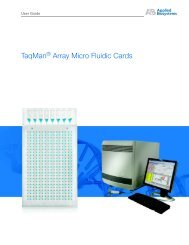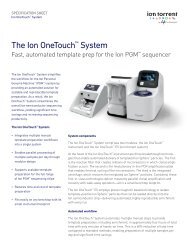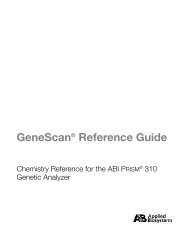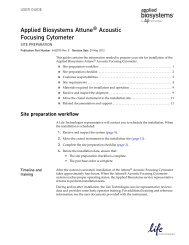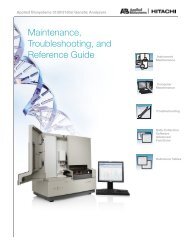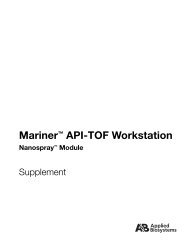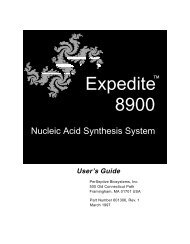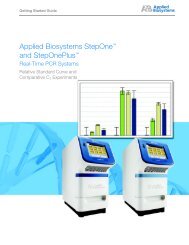3130/3130xl Genetic Analyzers Getting Started Guide, Rev - Applied ...
3130/3130xl Genetic Analyzers Getting Started Guide, Rev - Applied ...
3130/3130xl Genetic Analyzers Getting Started Guide, Rev - Applied ...
You also want an ePaper? Increase the reach of your titles
YUMPU automatically turns print PDFs into web optimized ePapers that Google loves.
Safety<br />
Chemical Safety<br />
Moving and<br />
Lifting Stand-<br />
Alone Computers<br />
and Monitors<br />
Operating the<br />
Instrument<br />
Chemical Safety<br />
Chemical Hazard<br />
Warning<br />
Do not attempt to lift or move the computer or the monitor without<br />
the assistance of others. Depending on the weight of the computer and/or the monitor,<br />
moving them may require two or more people.<br />
Things to consider before lifting the computer and/or the monitor:<br />
Make sure that you have a secure, comfortable grip on the computer or the monitor<br />
when lifting.<br />
Make sure that the path from where the object is to where it is being moved is clear<br />
of obstructions.<br />
Do not lift an object and twist your torso at the same time.<br />
Keep your spine in a good neutral position while lifting with your legs.<br />
Participants should coordinate lift and move intentions with each other before<br />
lifting and carrying.<br />
Instead of lifting the object from the packing box, carefully tilt the box on its side<br />
and hold it stationary while someone slides the contents out of the box.<br />
Ensure that anyone who operates the instrument has:<br />
Received instructions in both general safety practices for laboratories and specific<br />
safety practices for the instrument.<br />
Read and understood all applicable Material Safety Data Sheets (MSDSs). See<br />
“About MSDSs” on page xviii.<br />
CHEMICAL HAZARD. Before handling any chemicals, refer to<br />
the Material Safety Data Sheet (MSDS) provided by the manufacturer, and observe all<br />
relevant precautions.<br />
CHEMICAL HAZARD. All chemicals in the instrument, including<br />
liquid in the lines, are potentially hazardous. Always determine what chemicals have<br />
been used in the instrument before changing reagents or instrument components. Wear<br />
appropriate eyewear, protective clothing, and gloves when working on the instrument.<br />
About MSDSs Chemical manufacturers supply current Material Safety Data Sheets (MSDSs) with<br />
shipments of hazardous chemicals to new customers. They also provide MSDSs with the<br />
first shipment of a hazardous chemical to a customer after an MSDS has been updated.<br />
MSDSs provide the safety information you need to store, handle, transport, and dispose<br />
of the chemicals safely.<br />
Each time you receive a new MSDS packaged with a hazardous chemical, be sure to<br />
replace the appropriate MSDS in your files.<br />
xviii <strong>Applied</strong> Biosystems <strong>3130</strong>/<strong>3130</strong>xl <strong>Genetic</strong> <strong>Analyzers</strong> <strong>Getting</strong> <strong>Started</strong> <strong>Guide</strong><br />
DRAFT<br />
November 3, 2004 9:51 am, Safety_fm



